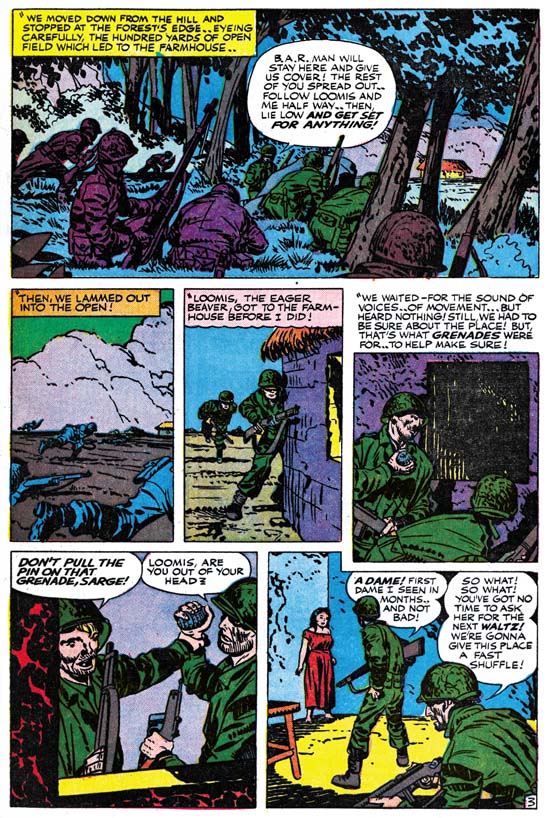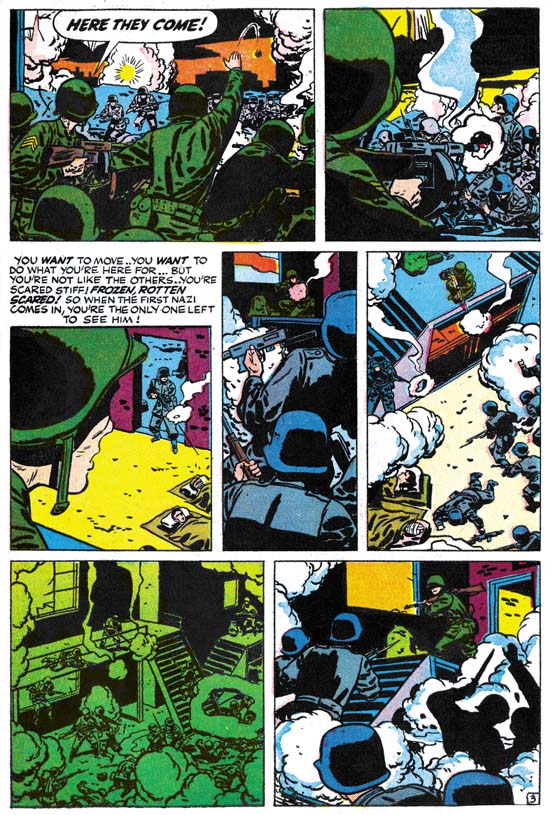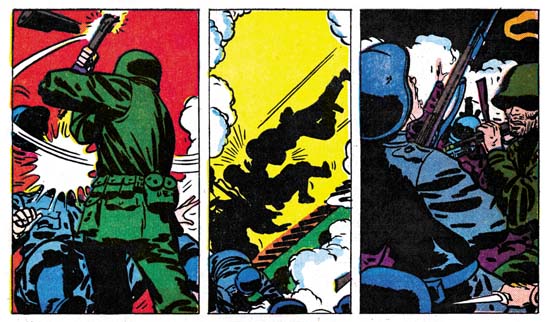
Foxhole Comics #2 (December 1954) “Booby Trap” page 3 by Jack Kirby
Most Foxhole stories are very short yet they have no feeling of being rushed. Jack Kirby’s story, “Booby Trap” is only six pages long but look at page 3 where he spends four panels on the approach of a Korean farmhouse. What a masterpiece this page is. The distant view of the farmhouse with the troops safely concealed by trees. The silent but exposed crossing of the field. The arrival at the farmhouse and the preparation for the use of a grenade. Ending with a sudden reprieve and the revelation about the presence of a female civilian. Kirby is renown for his handling of action but on this page he shows he can also be the master of suspense. He does it so well that it is a side of Kirby that you wished he did more often. As for real action there is plenty of that to follow. But for Jack action is up close and personal. His soldiers are real warriors who fight with knives or hand-to-hand. Even when a rifle is fired it is not from a distance but so close that there will be no second try if the first does not hit its mark.
But a comment about page 3 is in order particularly since I am showing it out of context from the rest of the story. Today with our post-Mi Lai concern about non-combatant casualties the soldier who stopped the throwing of the grenade would be viewed as the hero and the grenade owner as being callous at best. But this is the ’50s and the rest of the story makes it abundantly clear that the man who stops the grenade attack is actually a screw-up who does not take sufficient care while in enemy territory. As the “real” hero says in the text from panel 4
We had to be sure about the place! But, that’s what grenades were for… to help make sure!
This is the equivalent of shoot first and ask questions later.
I do not know if Kirby actually wrote the script. My impression of how Jack worked at the time was he and Joe provided a plot outline to a writer. When the writer returned with a script that Kirby would draw Jack would then make whatever alterations that he saw fit. Certain phrasing used in the story seem pure Kirby to me. Such as this gem from the last panel of page 3:
A dame! First dame I seen in months.. and not bad!
So what! So what! You’ve got no time to ask her for the next waltz! We’re gonna give this place a fast shuffle!
Before leaving my discussion about “Booby Trap” perhaps I should point out that the B.A.R. referred to in the first panel of page 3 is short for Browning Automatic Rifle. The B.A.R. man is shown in that panel as the one on the left in the foreground. In the story this acronym is used without any explanation. They just assumed that the reader would be familiar with the term. Although the B.A.R. man would show up again in the story and we will get a better view of his rifle, we will never get to see him fire it.

Foxhole Comics #2 (December 1954) “Replacement” page 3 by Bill Draut
From the same issue there is a story by Bill Draut that makes a good comparison piece to Kirby’s “Booby Trap”. “Replacement” is an even shorter work being only four pages long. In a previous discussion about Bill Draut I had commented that I thought Bill was a little uncomfortable with drawing action. I had come to that conclusion because in his early work Draut really did seem to have a little problem with things such as fight scenes. Most of the work that Bill did later was for romance comics and would not require action. But as this story shows (and at least one other in Police Trap) I was incorrect. Actually it should have been obvious that Bill would know how to handle action scenes, after all he served as a combat artist for the Marines during the war. His early shortcomings in this area probably was due to his then-inexperience in comic book art.

Foxhole Comics #2 (Decemberr 1954) “Replacement” part of page 4 by Bill Draut
I am sure there will be those who say that the reason that Draut handled the fight scenes in this story so well was due to having worked from Kirby layouts. But I do not at all believe that to be the case. Kirby likes to handle fighting “up close and personal”. Even the advance on the farmhouse that is imaged at the start of the post is done as if the viewer was actually a part of the operation. Bill on the other hand gives a bird eye view of the fight before he zooms into the thick of things. To me these are two very different ways of telling the stories. In “Replacement” The fight does becomes hand-to-hand on the next page, but even there Draut’s technique seems very different then that used by Kirby. Everything indicates to me that this story was not done using Kirby layouts.
As for the writing, I do not find any of those “pure Kirby-isms” like I see in “Booby Trap” and so many other S&K stories drawn by Jack. I still believe that Jack and Joe were involved in the providing plots to their writers. That would explain why, despite all the different artists that worked for Simon and Kirby, their productions have their own unique flavor. But when the script returned from the writers, Kirby was more apt to re-write material he was going to pencil then he was for stories to be drawn by other artists.
There is something special about the fight scene presented by Bill. Notice that the last four panels have no text, and this actually extends to the first three panels of the next page. Such a sequence of panels without text was quite unusual at the time, I cannot thing of another S&K production that has one. Years later Jim Steranko would cause a bit of a stir when he did something similar over two pages. After Steranko this technique has become more common.
My purpose in comparing Bill Draut’s story with the Jack Kirby piece is to show differences in approach. It is not a rating of one artist over another. Such a comparison really would be unfair to Draut. After all there really are not many artist in the same league as Kirby. Actually the only one I consider an equal to Jack is Will Eisner. But I feel that stories such as “Replacement” show how really fine an artist Bill Draut was.

